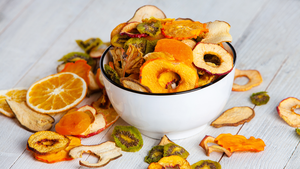Former FDA deputy commissioner weighs in on lead contamination in applesauce
Frank Yiannas, a former FDA deputy commissioner, says traceability is the major issue with food recalls, such as the recent one from WanaBana LLC involving applesauce pouches.

At a Glance
- Lead contamination in cinnamon applesauce has caused adverse effects in 52 children across 26 states.
- Frank Yiannas said the slow response to the outbreak has raised concerns about the need for better, faster food traceability.
- FDA’s upcoming traceability rule will require manufacturers of certain foods to maintain records with key data elements.
On Oct. 28, the state of North Carolina contacted FDA after finding elevated lead levels in four children. Cinnamon applesauce was quickly identified as the common thread. Recalls were rapidly initiated for applesauce pouches produced by WanaBana LLC and privately labeled as Schnucks and Weis brands.
As of FDA's latest announcement on Nov. 22, 52 children have suffered adverse effects. To date, confirmed complainants are less than 1 to 4 years of age. FDA is continuing to evaluate incoming adverse event reports.
An article published in The National Desk on Nov. 20 suspects more children have been exposed to high lead levels. While FDA reported 22 states with cases, reporters who reached out to state health departments identified 26 states with suspected cases. The investigation is ongoing.
An applesauce sample obtained by FDA from Dollar Tree was tested and found to contain 2.15 ppm lead. “The levels reported are concerning,” Frank Yiannas, former deputy commissioner of food policy and response at FDA, said. “While I’ve heard various plausible theories reported of how this could have happened, I think it’s prudent to let FDA complete their investigation to obtain an evidence-based explanation of how the contamination occurred or may have occurred.”
FDA hypothesizes that cinnamon is the source of lead contamination. “It remains unclear whether or not there is test data to support this hypothesis,” Yiannas explained. “If there is not, I suspect the FDA will not leave any stone unturned to determine the definitive source or sources of the contamination.”
The larger issue is the slowness of the response. “It has now been over three weeks and we still haven’t heard the source of the cinnamon and what other products it could have gone into,” Yiannas said. “There are reports of the recalled product still being found on retailers’ shelves this week.” The products are sold at the store level and on online platforms in the United States and other countries.
“All of this illustrates the need for better and faster food traceability to identify implicated product and retrieve it from stores’ shelves,” Yiannas noted. “Better traceability can also be used to trace forward how and where a contaminated ingredient made its way into other food products.”
Spice supply chains can be very complicated, as they pass through several countries and brokers. Spices can be mixed. Even though they can be sold via informal markets, Yiannas believes we can strive to make these supply chains more traceable and transparent.
“As illustrated in this instance, it can make a big difference in being able to understand and contain, in a timely and precise manner, a contaminated food event,” he said.
Prior to joining FDA, Yiannas served as VP of food safety at Walmart. “While working at the world’s largest food retailer, in 2007, we did some pilots with one of the world’s largest food manufacturers of baby food, where we were able to demonstrate using distributed ledger technology that all of the ingredients used in baby food jars could be traced to source with speed and specificity,” he emphasized. “It can be done. Ideally, if retail stores captured traceability lot codes at point of service, we could know what retail stores received contaminated product.”
Yiannas is credited as the architect of FDA’s upcoming traceability rule. FSMA 204 goes into effect in January 2026. Under the new rule, companies who manufacture, pack, process or hold certain foods are required to maintain records with key data elements associated with critical tracking events such as harvesting, initial packing, shipping, etc. Foods that are on the food traceability list, such as certain fruits, vegetables, cheeses, fish, shellfish, eggs and nuts will have to maintain traceability lot information throughout the supply chain. Companies that are subject to the rule must establish a traceability plan and be able to provide tracking information to FDA within 24 hours.
The new rule would not have applied to applesauce products because neither apples nor cinnamon appear on the food traceability list.
In a GS1 US video, “Traceability and FSMA 204 Insights with Frank Yiannas,” Yiannas said food traceability has been important to him in his tenure in the private and public sectors: “In almost every major food safety scare, food safety outbreak crises that I’ve had to manage over the course of my career, food traceability has been an Achilles heel to being able to do that well. A lack of traceability and transparency in the food system, let me repeat it, I believe [is] an Achilles heel in the food system.”
About the Author(s)
You May Also Like






